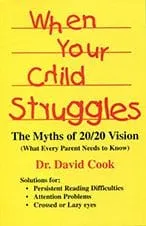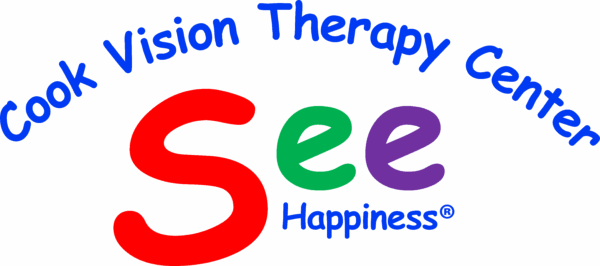Handwriting & Math Help
Getting It Down on Paper
Vision Therapy for Kids | Handwriting & Math Help Marietta, GA
At Cook Vision Therapy Center, we see a large number of bright children who struggle to get their thoughts down on paper. To understand why a child might have difficulty getting things down on paper, let’s try two demonstrations:
Understanding How Children Learn to Write: A Step-by-Step Journey
Grab a pencil and paper. Try copying the word below:

How did it go? This six-letter word might seem simple, but breaking it down reveals layers of complexity. Did you glance at the word repeatedly to replicate each curve and angle? How long did it take?
Now, let’s simplify. Copy these four symbols:
⚡✏️🔍📐
What challenges did you face? For instance:
-
Symbol 1 (⚡): Did you nail the proportions and spacing?
-
Symbol 2 (✏️): Were the lines angled precisely?
-
Symbol 3 (🔍): Did your curves mirror the original size?
-
Symbol 4 (📐): Were all six lines and their angles accurate?

Adults Write Automatically, Children Learn Analytically
As adults, writing flows effortlessly—like copying “Waving” without second-guessing strokes or spacing. But for young children, writing mirrors the meticulous effort required to replicate abstract symbols. Imagine a child tackling Waving:
-
Decoding the W’s three angled lines.
-
Perfecting the *a*’s rounded curve and the *g*’s tail.
-
Aligning the *v*’s sharp angle and spacing letters evenly.
Without mastering foundational concepts like shapes, spatial awareness, and motor control, writing becomes an uphill battle.
Why Eye-Hand Coordination Challenges Make Writing Frustrating for Kids
Let’s try an experiment. Copy this sentence under three strict rules:
-
Work neatly and quickly.
-
Finish on time, or lose recess.
-
Use your non-dominant hand (left hand if right-handed, right hand if left-handed).
Ready? Begin!
If this task felt overwhelming, you’ve just experienced what children with eye-hand coordination challenges face daily. The frustration of shaky lines, poor spacing, or letters “floating” off the page isn’t laziness—it’s often rooted in physical or visual barriers.
What Causes Eye-Hand Coordination Issues?
-
Motor Skill Delays: Weak hand muscles or fine motor difficulties, often addressed by occupational therapists through exercises like grip strengthening.
-
Visual Challenges: Conditions like convergence insufficiency (misaligned eye muscles) prevent kids from focusing on the pencil tip, leading to messy handwriting.
Did You Notice?
-
Children with these struggles may avoid writing tasks or take longer to complete them.
-
Their eyes might wander away from the pencil, causing uneven spacing or slanted lines.
The Good News: Solutions Exist!
Targeted vision therapy and occupational therapy can retrain the brain-eye-hand connection. For example, vision therapists use tools like prisms or tracking exercises to improve focus, while occupational therapists work on grip and precision.
The Hidden Role of Visual Perception in Math
Visual perception is the brain’s ability to interpret spatial relationships, recognize patterns, and organize information. Weaknesses here directly affect:
- Number Alignment: Misaligned columns (e.g., 12+5 written as 1|2+5) due to poor spatial judgment.
- Geometry & Graphs: Difficulty interpreting shapes, angles, or charts without hands-on manipulation.
- Multi-Step Problems: Losing place in word problems or equations due to inefficient visual tracking.
3 Ways Visual Perception Impacts Math Skills
-
- Spatial Reasoning Deficits
- Trouble judging distances between numbers or symbols (e.g., uneven spacing in equations).
- Struggles with fractions, decimals, or geometry due to poor mental manipulation of shapes.
- Example: A student misreads “6” as “0” because they can’t distinguish the gap in the loop.
- Visual Tracking Errors
- Skipping steps or losing focus when shifting gaze between a whiteboard and a worksheet.
- Frequent “careless mistakes” (e.g., copying 13+7 as 31+7).
- Visual Memory Gaps
- Difficulty recalling number patterns (e.g., multiplication tables) despite repeated practice.
- Spatial Reasoning Deficits
Signs Your Child’s Math Struggles May Be Vision-Related
- Avoids worksheets but excels in oral math quizzes.
- Frequently erases or misaligns numbers in columns.
- Complaints of headaches or fatigue during math homework.
- Struggles to interpret graphs, maps, or geometry diagrams.
Why Early Intervention Matters
As math becomes more abstract in middle school, unaddressed visual perception gaps lead to:
- Declining grades despite high effort.
- Anxiety around STEM subjects.
- Avoidance of advanced courses.
Our therapy plans are tailored to Marietta, GA school curricula, ensuring skills align with classroom demands like standardized testing and digital/hybrid learning tools.
Why Does My Child Suddenly Hate Math?
A child’s sudden math aversion often stems from visual perception deficits, not laziness. Poor spatial judgment or eye-tracking struggles make tasks like aligning numbers or interpreting graphs physically exhausting.
Signs to Watch:
- Avoids worksheets but excels verbally.
- Frequent headaches during math homework.
- Repeated “careless” errors (e.g., misread numbers).
Is My Child Lazy or Is It a Vision Problem?
Children with undiagnosed vision issues often appear unmotivated due to:
- Slow writing speed from poor eye-hand coordination.
- Fatigue from double vision or blurry text.
- Frustration with tasks requiring visual memory.
Key Difference: Laziness fluctuates; vision struggles persist across tasks.
How Can I Stop Homework Meltdowns?
Homework battles often arise from undiagnosed eye strain or visual stress. Reduce frustration with:
- Timed Breaks: 10 minutes of work, 2-minute rest.
- Slant Boards: Improve posture and reduce neck strain.
- Vision Therapy: Address root causes for long-term relief.
My Gifted Child Can’t Write Neatly – Why?
Bright, verbally skilled kids may have dysgraphia or visual-motor delays, causing:
- Inconsistent letter sizing.
- Poor spacing between words.
- Slow processing speed.
Take Action Today
If your child in Marietta, GA, understands math concepts but struggles to execute them, the issue may lie in their visual perception. Contact Cook Vision Therapy Center to schedule a Comprehensive Functional Vision Exam and discover how targeted therapy can transform their math confidence.
Free Internet Screening and Phone Consultation
If you or your child struggles with reading, call for a Free Phone Consultation. End the struggle!
FAQs
-
How does visual perception impact math skills?
Weak visual perception affects spatial reasoning, causing errors in number alignment, geometry, or graphs. Kids may misread symbols (e.g., 6 vs. 0) or lose focus mid-problem. Vision therapy targets these gaps, enhancing accuracy in Marietta school curricula.
-
What are signs of eye-hand coordination issues in children?
-
Can vision therapy help math homework struggles?
-
How do I know if math aversion is vision-related?
-
What causes poor number alignment in math problems?
-
Why does my gifted child write slowly or messily?
-
How does vision therapy improve handwriting skills in children?
-
When should I consider vision therapy for my child struggling with handwriting or math?
-
Can vision therapy help children with learning difficulties related to vision?
-
How long does it usually take to see improvements in handwriting after starting vision therapy?
-
What is vision therapy for handwriting and math?
-
Can vision therapy reduce handwriting fatigue?
-
Are vision problems common in children with learning difficulties?
-
What signs indicate a child might need vision therapy for handwriting?
Check Out Our Resources
Dr. Cook’s Publications:
- Authored books VISUAL FITNESS and WHEN YOUR CHILD STRUGGLES.
- Published articles in top optometric journals.
- His article “Eyesight, infinity and the human heart” was voted “Best Non-Technical Article” by the Association of Optometric Editors.





